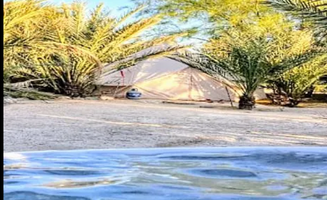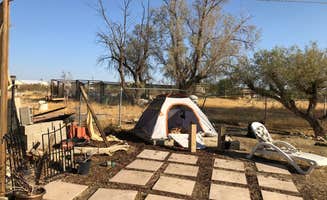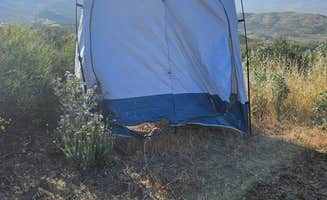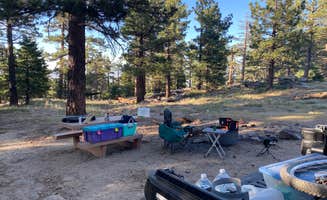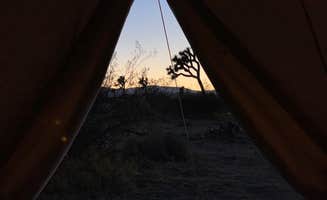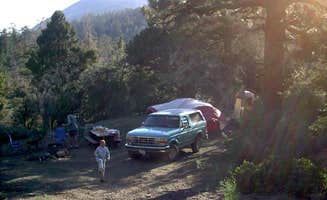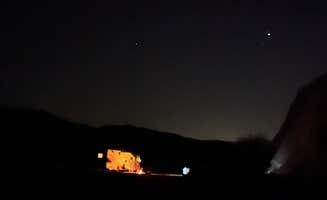Tent camping near Cathedral City, California typically involves handling significant elevation changes, as most wilderness camping areas sit at 9,000+ feet in the San Jacinto mountains. Temperatures can fluctuate dramatically between the desert floor and mountain camping zones, with differences of 30-40°F common during summer months. Winter camping often requires snow equipment for access to higher elevation sites.
What to do
Trail exploration from Tool Box Springs: Access the Ramona Trail directly behind the washhouse for moderate hiking. "Awesome spot! Just got back this past weekend and the service road to get up was absolutely covered in mud and snow. Would 100% recommend it, but if it's been snowing or raining, you'll need high clearance and 4x4. And, be mindful that the drive is about 30-45 minutes up the mountain" reports one camper at Tool Box Springs Yellow Post Campground.
San Jacinto Peak summit attempts: Use wilderness camping areas as a basecamp for tackling this challenging 10,834-foot peak. "We took the tram up from palm springs and backpacked to the campground before summiting up San Jacinto peak. The views were breathtaking and the elevation was a killer. It took us longer than we expected" notes a visitor to Round Valley Campsite.
Equestrian trails: Bring horses to access extensive trail networks, including a remarkable 35-mile route connecting to southern Joshua Tree. "Huge open horse camp with 10 corrals, picnic tables, bbqs and fire rings, pick your spot anywhere you like. Almost all sloped but not awful. Trails are amazing. There is even an overland trail from here to the south end of Joshua Tree NP which is around 35 miles long" states a review from Black Rock Equestrian Campground.
What campers like
Solitude and isolation: Many backcountry sites offer exceptional privacy away from crowds. "We didn't see a single person camping, it was very isolated so make sure to let friends/family know your travel plans and when to expect you to return. The permits have this info but just be safe. It is a well traveled trail year round but weather is unpredictable."
Water accessibility: Some camping areas feature reliable water sources during certain seasons. At Little Round Valley Campground, one camper mentioned: "We did it in late August, and there was still water running in the stream across from the camp. There are several spots that you need to get a permit for, and they're spread out right off the trail."
Wildlife viewing: The diverse ecosystems support abundant animal sightings. "Lots of wildlife. Raccoons in the night, gray squirrel, other squirrels, many birds. So much" reports a Labor Day weekend camper who found themselves the only occupants at Tool Box Springs out of five available sites.
What you should know
Permit requirements: Many primitive sites require advance registration that fills quickly. "Reservations go fast so you need to submit your permit starting 8 weeks before your trip, however waiting until 4 weeks may be too late. The permit only reserves your space on the mountain you will need to select your exact campsite once you get to the ranger station after getting off the tram."
Access challenges: High-clearance vehicles are essential for certain camping areas. As one Tamarack Valley Campground visitor explains: "I loved the site! It has a bathroom at the very start, but can be a little ways from the sites. The only downfall is without a high clearance vehicle, it took me an hour and a half to go six miles up, and still scraped and almost got stuck."
Temperature extremes: Prepare for cold nights even during summer desert heat. "We stayed at the round valley campground in March of this year. There was still some snow and it was beautiful. The campground is nice but there are no facilities so make sure to bring plenty of water or filtration device to filter the water."
Tips for camping with families
Regional park alternatives: Consider developed campgrounds for easier family camping. At Yucaipa Regional Park, one camper notes: "There's a lot to do here, including fishing, playgrounds, and even a waterpark in the summer. The bathrooms are decent, no showers. There's no larger wildlife, like bears, so less stressful when you have pets or kids. Plenty of space to bring bikes and ride around."
Bug protection: Insect activity can be intense during certain seasons. "This site would've been perfect, and I mean perfect, but the flies were unbearable. I planned to stay two nights but I couldn't make it past the next morning. Spring time and fall are the best here, less flies and insects," advises a Tool Box Springs visitor.
Water planning: Reliable drinking water is scarce at most wilderness sites. "The campground is nice but there are no facilities so make sure to bring plenty of water or filtration device to filter the water. Permits are required for both day hikes and overnight," explains a Round Valley camper.
Tips from RVers
Site selection: Choose carefully based on shade and grade. At San Bernardino National Forest Santa Rosa Springs Campground, one RVer shares: "There are 16 yellow post sites along the Santa Rosa Truck Trail (7S02) from hwy 74. Most of the sites are beyond the springs that are flowing through a faucet at Santa Rosa Springs. I stayed at #13 in a roundabout of 4 campsites."
Road conditions: Research current access roads before attempting remote sites. "Definitely want clearance but I did most in rwd. Saw a stock Tacoma at the top. I stayed at campsite 6 and it was very enjoyable. It had a good breeze going. Campsite had fire ring with grill and a wood table that gave out splinters every time I touched it."
Utility planning: Most wilderness sites lack hookups; plan accordingly. "Some sites have better shade than others. I'm here in the heat but my AC is keeping up. Full hookup. Verizon service is only 2 bars but I can still work."


